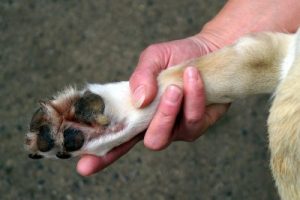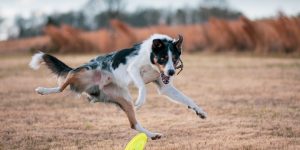Why is My Dog Limping?
It can be quite worrying for dog owners when they witness their dog limping. There are many reason why dogs might be reluctant to put weight on one or more feet, which results in limping. In this Holiday4Dogs article we will look at possible of lameness in dogs.
The most important consideration is whether is the dog is able to bear any weight on the affected limb. If the onset of lameness is sudden and the dog appears to be in pain, or distress, it is important to seek veterinary attention straight away.
Mild to moderate limping – what to look for.
In order to try and identify which limb is affected, observe your dog walking, from both sides. Get a helper to walk the dog back and forth on a lead. See if you notice which leg he is avoiding putting weight on.
Next, make a physical examination of his foot and leg, paying particular attention to the following areas;-
Pads –
It is quite common for dog’s paws to become damaged by sharp objects, which will cause them to limp. They can also become sore from walking on hot, or stony ground.
In addition, irritation may occur by contact with chemicals, such as substances used to treat icy roads and pavements in winter.
Toes –
Check individual toes and nails for signs of cuts or breaks. If your dog has caught his nail and torn it down to the ‘quick’ (the nerve sensitive part of the nail), this will be very uncomfortable for him.
You may even notice blood around the nail bed. In this case, it will certainly require veterinary attention.
Also, examine the webbing between the dog’s toes. Make sure there has been no damage and there is no sign of infection, or abscesses.
Grass seeds, in late spring and summer, are a common cause of limping in dogs because they easily penetrate skin – particularly the area of soft skin between the toes. Many grass seeds are barbed. Therefore, it can make it almost impossible to remove them, without leaving some of the seed behind. This then, has the potential to cause infection and will require veterinary intervention.
Joints –
There are three main joints in a dog’s front and hind limbs. Canine front legs are made up of the wrist, (carpus), elbow and shoulder. The back legs consist of the ankle (tarsus), knee (stifle) and hip. Check each of these areas by applying light pressure, or gently squeezing to see if this causes a reaction in the dog. You can also try picking up the limb you think is affected and manipulate the leg through a normal range of motions. Note if the dog appears to be in any discomfort.
Bones –
With 321 bones in a dog’s body, any damage, fracture, or bruising could cause the dog to be uncomfortable enough to limp. Look for any swelling, or other signs that the dog’s body is not symmetrical.
Consider whether your dog may have suffered an injury over the last few hours before he was limping.
Jumping and twisting, especially in young dogs, can be enough to cause trauma to growing joints.
The dog’s age is also important in establishing the reason for limping. Older dogs may be developing arthritis, for example.
It is also possible that your dog could be suffering from hip, or elbow dysplasia or, other diseases such as canine degenerative myelopathy. This commonly affects larger breeds, such as Labradors and German shepherd dogs. Bones and joints can also be affected if the dog is overweight.
Conclusion.
It is very important to take care when examining your dog. A dog in a lot of pain, will often bite as a natural reaction. If the dog’s limping is severe and sudden in onset, or if the dog appears withdrawn and listless and unable to weight bear – seek veterinary attention straight away.
Our experienced carers will always pay close attention to the health of your dog while they are in their care. Should your dog require veterinary treatment, this will be attended to either with your own designated vet, or the nearest surgery to the carer in the event of an emergency.


